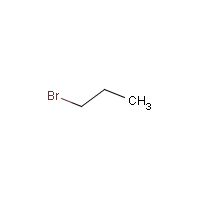1-Bromopropane
Agent Name
1-Bromopropane
CAS Number
106-94-5
Formula
C3-H7-Br
Major Category
Solvents

Synonyms
Propane, 1-bromo-; Propyl bromide; n-Propyl bromide; [ChemIDplus] n-Propylbromide; Propylbromide;1-BP; [ACGIH] UN2344
Category
Brominated Solvents
Description
Colorless liquid; [ACGIH]
Sources/Uses
Used as a solvent substitute "to clean metals and electronics, in adhesive and coating applications, and in aerosol propellant applications." Has also been used to replace perchloroethylene in dry cleaning; [ACGIH]
Comments
If left on clothes, may cause reddening of skin; [CHRIS] A case of peripheral neuropathy was reported in a 19 year old male after 2 months of occupational exposure to a degreasing solvent containing 95.5% 1-BP. Reproductive toxicity and hepatotoxicity are observed in animals repeatedly exposed to levels above 250 ppm and 200 ppm, respectively. LOAEL was 1.28 ppm for loss of vibratory sensation in toes and reduced RBC count in 60 factory workers exposed to 1-BP. TLV Basis: CNS impairment; peripheral neuropathy; hematologic effects, reproductive, and developmental toxicity; [ACGIH] 1-BP causes neurotoxicity and reproductive toxicity in animal studies. A study of 27 workers producing 1-BP in a Chinese factory found evidence of toxicity to the CNS and peripheral nerves. [PMID 15345346] Six cases of neurotoxicity (possible central distal axonopathy) were reported among foam cushion gluers. [PMID 17453879] A cross-sectional study of 60 female and 26 male workers in three 1-BP factories in China found neurotoxicity in females exposed to >1.28 ppm. [PMID 20657306] Potential adverse effects include CNS depression and anesthesia; [HSDB] See "Carcinogenicity of some industrial chemicals," Volume 115. [IARC, News Release, 23 February 2016] See "2-Bromopropane."
Biomedical References
Exposure Assessment
Skin Designation (ACGIH)
No
TLV (ACGIH)
0.1 ppm
Vapor Pressure
111 mm Hg
Lethal Concentration
LC50 (rat) =253,000 mg/m3/30 min
Explanatory Notes
VP from ChemIDplus;
Reference Link #2
NFPA
high ambient temp required
Adverse Effects
Neurotoxin
Acute solvent syndrome
Hepatotoxin
Hepatoxic (a) from occupational exposure (secondary effect) or (b) in animal studies or in humans after ingestion
Reproductive Toxin
Yes
IARC Carcinogen
Possible (2b)
NTP Carcinogen
Anticipated human carcinogen
ACGIH Carcinogen
Confirmed Animal
Diseases, Processes, and Activities Linked to This Agent
Diseases
Occupational diseases associated with exposure to this agent:
Processes
Industrial Processes with risk of exposure: